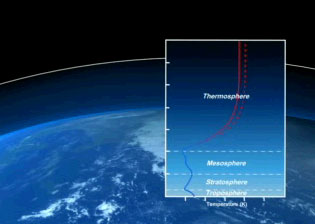Global warming could save NASA millions in fuel costs
Global warming could save NASA millions in fuel costs
mongabay.com
December 11, 2006
Carbon dioxide emissions produced from the burning of fossil fuels will produce a 3 percent reduction in the density of Earth’s outermost atmosphere by 2017, according scientists from the National Center for Atmospheric Research (NCAR) and Pennsylvania State University (PSU).
The research, appearing in the current issue of Geophysical Research Letters and presented today at the annual meeting of the American Geophysical Union in San Francisco, says that the change could save NASA and the European Space Agency millions of dollars in fuel costs since lower density in the thermosphere “reduces the drag on satellites in low Earth orbit, allowing them to stay airborne longer.”
The researchers say that increasing levels of carbon dioxide will cool and contract the thermosphere, the outmost layer of the atmosphere. A statement from National Center for Atmospheric Research (NCAR) explains:
 Even though emissions of carbon dioxide warm the lower atmosphere, they have the opposite effect on the upper atmosphere. The reason has to do with the difference in density. Near the Earth’s surface, carbon dioxide absorbs radiation escaping Earth, but before it can radiate the energy to space, frequent collisions with other molecules in the dense lower atmosphere force the carbon dioxide to release energy as heat, thus warming the air. In the much thinner thermosphere, a carbon dioxide molecule absorbs energy when it collides with an oxygen molecule, but there is ample time for it to radiate energy to space before another collision occurs. The result is a cooling effect. In this video clip, NCAR scientist Stan Solomon explains this phenomenon, which is illustrated by the animation. (Video, animation, and caption ©UCAR) |
Carbon dioxide cools the thermosphere, even though it acts to warm the atmosphere near the Earth’s surface (the troposphere). This paradox occurs because the atmosphere thins with height. Near the Earth’s surface, carbon dioxide absorbs radiation escaping Earth, but before the gas molecules can radiate the energy to space, frequent collisions with other molecules in the dense lower atmosphere force the carbon dioxide to release energy as heat, thus warming the air. In the much thinner thermosphere, a carbon dioxide molecule absorbs energy when it collides with an oxygen molecule, but there is ample time for it to radiate energy to space before another collision occurs. The result is a cooling effect. As it cools, the thermosphere settles, so that the density at a given height is reduced.
The researchers say that the thermosphere is also affected by the 11-year cycle of solar activity during which ultraviolet light and energetic particles wax and wane causing shifts in the temperature and thickness of the upper atmosphere.
The cooling of the thermosphere will reduce give satellites a longer life, according to the researchers.
“Many satellites, including the International Space Station and the Hubble Space Telescope, follow a low Earth orbit at altitudes close to 300 miles,” explained a NCAR statement. “Over time, the upper atmosphere drags the satellites closer to Earth. The amount of drag depends on the density of the thermosphere, which is why satellite planners need better predictions of how the thermosphere changes.”
Satellite operators noticed the solar cycle changes in density at the very beginning of the space age,” NCAR scientist Stan Solomon, a co-author of the study. “We are now able to reproduce the changes using the NCAR models and extend them into the next solar cycle.”
“We’re seeing climate change manifest itself in the upper as well as lower atmosphere,” he continued. “This shows the far-ranging impacts of greenhouse gas emissions.”
This article is based on a news release from NCAR.